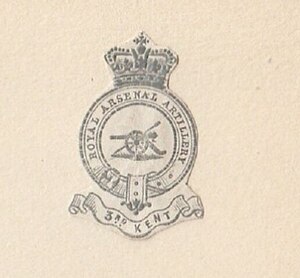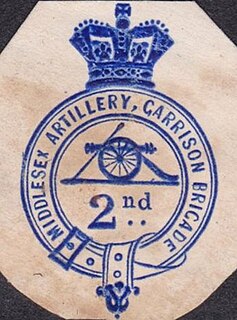In December, the Ulster Division's artillery arrived from England, and the London Divisional Artillery was transferred to the 38th (Welsh) Division, which had also arrived in France minus its own artillery. 1/II London Bde served with the Welsh Division from 11 December 1915 to 1 January 1916. It was next attached to IV Corps Artillery until the end of February. By now, 1st London Division (now numbered 56th (London) Division) was being reformed in France and its divisional artillery was finally able to rejoin. [13] [15] [18] [20]
Gommecourt
The first major action for CCLXXXI (281) Bde came at the Battle of the Somme, and there are detailed accounts of its actions. 56th Division's task for the opening day of the Somme Offensive (the 'Big Push') was to attack the south side of the Gommecourt Salient as a diversion to support the main attack further south. [22] [23] [24] [25]
The divisional artillery was disposed in three groups. 281 Brigade under Lt-Col C.C. Macdowell, together with 109 Bty from 283 Bde, formed the Southern Group ('Macart'). During the preliminary bombardment Macart was under VII Corps control, but from Zero Hour it was assigned to support the assaulting infantry of 168th (2nd London) Brigade. The batteries began moving into position in late May 1916 and then began to register their targets during June, 281 Bde being the first to open fire. [26] [27] [28]
The Macart Group's role was to 'search' the enemy trenches, villages, woods and hollows. B/281 Battery was in a fold of ground about 1500 yards west of the British-held village of Hébuterne, while C/281 and 109 Bty were beside the Sailly– Hébuterne road, about 500 yards from the latter village and just over 3000 yards from the German trenches. The howitzers of D (H)/281 Bty were dug into the gardens and orchards behind Hébuterne, and could range into the German rear areas. [27] [29]
Five days of intense bombardment were planned leading up to the attack, designated U,V, W, X and Y days, but the whole attack was delayed by two days, so there was seven days of bombardment culminating in Z Day on 1 July. The two additional days were used for Interdiction of enemy movement and repair parties, to complete the wire-cutting and counter-battery tasks, and to deceive the enemy. The wear on the guns and the unexpected ammunition expenditure meant that after the intended peak on Y Day (28 June) the Macart Group's firing actually fell away on the additional Y1 and Y2 Days, giving the defenders time to reorganise and repair their positions. [27] [29] [30] [31] [32] The division's batteries and observation posts (OPs) also suffered from German counter-battery fire. Lieutenant John Ball of 281 Bde was killed on 27 June when his OP was hit. [33]
Each day of the firing programme had included an intense bombardment starting at 06.25, reaching a crescendo at 07.20 and lifting at 07.45; on Z Day (1 July) this lifted 15 minutes earlier than usual, in an attempt to deceive the enemy. 56th Divisional artillery was allocated 11,600 rounds for this final 65 minutes, amounting to three rounds per minute for each 18-pounder gun and 4.5-inch howitzer. A smoke screen was laid at 07.25, and under its cover the infantry went 'over the top' and assembled in No man's land. Then at Zero Hour, 07.30, the guns lifted to pre-arranged targets in the German support and reserve lines while the infantry began their assault. [34] [35] [36]
Having reverted to divisional control at Zero Hour, the 18-pounders had a series of very short lifts, almost amounting to a creeping barrage. The first lift was onto the German reserve trench, on which they fired for four minutes, then they fired for six minutes just beyond it, and then swept the communication trenches for 12 minutes. Next they shifted to the infantry's second objective for eight minutes. This programme was intended to conform to the infantry's plan of attack. [37]
At first this went well for 56th Division. Despite casualties from the German counter-bombardment on their jumping-off trenches, the smoke and morning mist helped the infantry, and they reached the German front line with little loss and moved on towards the second and reserve lines. The artillery OPs reported the signboards erected by the leading waves to mark their progress. On 168 Bde's front, the London Rifle Brigade found the wire well cut, except at Point 94 where the shelling had piled it into mounds that still presented an obstacle, and the battalion reached Gommecourt Park and began to consolidate. But the Queen Victoria's Rifles struggled to get through narrow gaps in uncut wire and met fierce resistance at the Cemetery, so that the following battalion, the Queen's Westminsters, got mixed up with them while trying to push through to the second objective, the Quadrilateral. The Germans began counter-attacking about an hour after Zero, and their heavy barrage on No man's land and their own front trenches made it almost impossible for reinforcements and supplies to be got forward to the assaulting battalions, who were now cut off. On the other side of the Gommecourt Salient, the assault of the 46th (North Midland) Division was a disaster, bogged down in mud and uncut wire, and the defenders could turn all their attention to the 56th Division. [38] [39] [40] [41]
Although VII Corps' heavy guns and 56th Division's howitzers tried to suppress the German artillery, the situation was too confused for the OPs and spotter aircraft to allow the divisional artillery to provide close support for the infantry. Several of the field guns were also out of action with broken spring. Even when repaired, the guns had to conserve ammunition later in the day. [42] By 12.30 the counter-attacks were beginning to drive 168th Bde out of its gains and at about 13.00 the isolated battalions in the German lines began to crumble. At 13.30 men were leaving the German positions and returning to the British lines, while the reserve units trying to cross No man's land were virtually destroyed by the German barrage. By mid-afternoon 168th Bde held only a 400-yard stretch of the German front line trench and was cut off. The field batteries were ordered to conserve ammunition in case of a German attack. All remaining gains had to be abandoned after dark. [43] [44] [45] [46]











